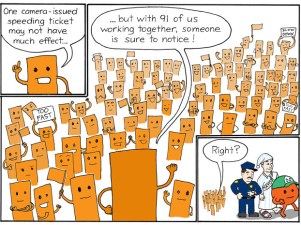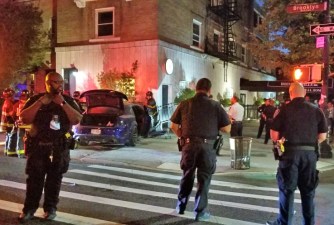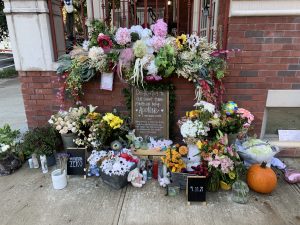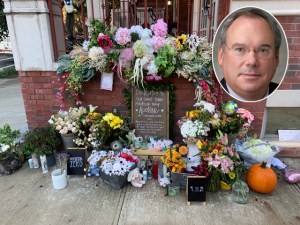Failure has many fathers.
The reckless driver who hit and killed a 3-month-old baby at a Brooklyn intersection on Saturday should never have been behind the wheel that day — his license to drive was suspended, he’s racked up scores of speeding tickets, and he’s previously been arrested for driving without a valid license — but the criminal justice system and its political architects failed to keep him off the road.
According to police, 28-year-old Tyrik Mott was racing the wrong way down Gates Avenue in Fort Greene in his 2017 Honda Civic with Pennsylvania plates when he plowed into another vehicle at about 6:20 p.m. The two cars careened into three pedestrians: a 33-year-old woman, a 36-year-old man, and 3-month-old Apolline Mong-Guillemin, who was killed. Mott initially fled on foot, police said, but was later arrested and charged with carjacking and robbery, but nothing immediately related to the death, injuries or the reckless driving.
Immediately after the crash, Mott’s 91 camera-issued speeding tickets since 2017 became the focus of nearly universal ire. How could a driver who has had so much regular contact with the city’s vaunted automated enforcement system — receiving 35 camera-issued tickets just this year alone — still be on the road to kill?
Oh, there’s a simple explanation:
“There’s no legal mechanism right now to really help ensure that egregiously reckless drivers like this stay off the road,” said Marco Conner of Transportation Alternatives. “Actually seizing the vehicle is really the only solution here.”
And therein lies a story.
Failure at the state(s) level
Neither Department of Motor Vehicles — in New York or the Keystone State, where Mott likely illegally registered his car to commit insurance fraud — nor the Brooklyn District Attorney’s office was able to keep Mott off the road, despite a well-documented history of recklessness.
According to the New York State DMV, Mott’s license had been suspended in April, meaning he should not have even been driving on Saturday when he killed baby Apolline. In addition, he has four previous suspensions for failing to answer summonses, and for failing to respond to a “driver responsibility assessment” — a fee for certain traffic offenses or for accumulating six or more points on a driver’s record within six months. But it’s unclear who or what agency — if any — is responsible for ensuring that Mott complies with the summonses and notices he’s sent, or if he’s even received them (given the Pennsylvania address he is likely using to register his car). Neither the Department of Finance nor the DMV offices in either state could answer questions about the address associated with Mott’s license plate, and the tickets that have accrued on the car.
The sordid driving record of Tyrik Mott’s Honda Civic began on June 30, 2017, when the car was slapped with its first serious reckless driving summons for running a red light on McDonald Avenue at Vanderbilt Street in the Windsor Terrace section of Brooklyn. Over the next six months, Mott’s car was caught on camera speeding six times and running red lights two more times.
But he finally attracted the attention of law enforcement in February, 2018, when he was slapped with a violation for cutting someone off without signaling at Atlantic and Pennsylvania avenues, according to a law enforcement source who has seen the sealed court files. Mott was fined, thought is is unclear how much or whether he paid. It is also unclear if anyone involved in the case — a judge, a cop, a Department of Finance ticket processing clerk, anyone — knew that at the time of that violation, Mott was an accident waiting to happen.
And Mott’s reign of terror was only beginning.
He was pulled over by cops in February, 2021 for an improper headlight, and was then was arrested for driving without a license. But a Brooklyn judge (whose name was not immediately available) let Mott walk in May with an ACD — an adjournment in contemplation of dismissal — which allowed Mott’s case to be dismissed in six months, despite the dozens of speeding tickets he had already accumulated. if he stayed out of trouble. It is unclear why that judge released Mott with the ACD; clearly, Mott’s driving record would have been available to the court.
And Mott did not stay out of trouble. He kept driving in violation of his license suspension — and kept driving recklessly, racking up at least 16 camera-issued speeding tickets and five camera issued red-light tickets since the May dismissal. He also got at least nine non-moving violation tickets for such transgressions as blocking a hydrant or a bus lane — and those tickets are written by humans who also failed to keep Mott off the road. It is unclear whether NYPD traffic enforcement officers have a system in place to catch big fish like Mott when they are writing routine parking tickets.
Whatever the case, nothing stopped Mott from continuing to drive. His multiple license suspensions weren’t enough — as they similarly are not enough in other tragic fatal crashes. After someone’s license is suspended, state authorities still apparently lack the authority to physically prevent them from driving, said State Sen. Andrew Gounardes (D-Bay Ridge) at the crash site on Monday.
“We are somewhat limited in our ability to have the state remove the person from their vehicle,” said Gounardes. “We need action … from all of us. There is no reason why this has to continue happening.”
Blood on Hizzoner’s hands
In the wake of baby Apolline’s death, Mayor de Blasio came under fire for his administration’s delayed implementation of the Dangerous Vehicle Abatement Program, a city law passed in early 2020 that would require drivers with 15 or more camera-issued speeding tickets or five red-light tickets in any 12-month period to take an in-person safety course or have their cars impounded by the sheriff.
Mott himself might have had his car impounded had Mayor de Blasio acted with urgency.
The bill, then called the Reckless Driver Accountability Act — was introduced by by Council Member Brad Lander in June, 2018. But more than a year later, in September, 2019, the mayor told Streetsblog that it was not a major initiative for him, saying he was unfamiliar with the bill and that he would devote his attention to other bills that were “pending most urgently.”
City Hall’s behind-the-scenes negotiating delayed and then watered-down the bill until it finally passed in February, 2020. Eight months later, or on Oct. 26, 2020, according to Lander’s office, drivers’ infractions were supposed to start counting against that 15-or-5 limit. But in May, 2020, de Blasio revealed that he would not allocate the $1.6 million needed to fund the program, which would be run by the Department of Transportation, in his $89.5-billion budget for fiscal year 2021, citing the city’s fiscal crisis due to the Covid-19 pandemic.
The funding, which would have represented less than .0018 percent of the overall budget, would have included such key elements of the program, such as writing and sending the tickets, and running the mandated in-person courses across all five boroughs. If a driver failed to the take the class, his or her car would be impounded.
Finally, in February, 2021, the de Blasio administration announced it would fund the program and that classes would start this fall. Fall starts in seven days, and the Department of Transportation still cannot say when exactly the program will begin, according to Lander.
“We are failing utterly to hold repeatedly reckless drivers accountable for endangering the lives of their neighbors — and too many children have paid the price,” the Brooklyn lawmaker and presumptive Comptroller said. “The Reckless Driver Accountability Act that I introduced three years ago, and the Council passed 18 months ago still isn’t up and running, and we have no clear timeline for when it will be. The speed and red-light cameras have already collected the data that identifies the most reckless vehicles on our streets.”
Data crunching by Streetsblog contributor Steven Bodzin shows that hundreds of drivers — perhaps more than several thousand — have already gotten enough speeding or red-light tickets since last September to meet the threshold for having to take the course or risk losing their car. Here’s a chart of just the speeding tickets since Jan. 1, 2021 (if you scroll down or click “Summary Table,” you’ll see that 1,000 drivers have at least 27 camera-issued speeding tickets):
Another chart shows how many drivers have reached the five red-light ticket standard in 2021 alone (more than 1,000 drivers have reached that threshold so far this year):
Nonetheless, on Monday, the mayor called for more action … from everyone but himself. He especially called out Albany lawmakers, who have failed to pass a package of bills called the Crash Victim Rights and Safety Act that would allow, among other things, New York City to operate speed cameras at all times, set its own speed limit, lower the blood alcohol content limit for DWIs from from .08 to .05, and require that drivers pass bicyclists at a minimum of three feet.
https://twitter.com/BrooklynSpoke/status/1437489307837767680?ref_src=twsrc%5Etfw%7Ctwcamp%5Etweetembed%7Ctwterm%5E1437490395550732291%7Ctwgr%5E%7Ctwcon%5Es2_&ref_url=https%3A%2F%2Fnyc.streetsblog.org%2Fwp-admin%2Fpost.php%3Fpost%3D466312action%3Dedit
“First of all, our laws in this state are still too lax when it comes to reckless drivers, and there’s a chance to fix that now,” the mayor said.
He added that 24/7 speed cameras would “protect lives [and] change behavior,” but the existing cameras have certainly caught Tyrik Mott plenty of times. In fact, none of the bills in the package are germane to the Apolline Mong-Guillemin killing.
“(Those bills) would make no difference for this guy,” said Conner, slamming the mayor for stalling on the Lander bill, for which Conner predicts the mandated safety courses won’t start until months into 2022.
“The mayor controls the streets [and] has the power to make them safer through redesign and for more than a year has had the power to implement (the Dangerous Vehicle Abatement Program) to ensure people like that stay off the road, but he totally failed to do that,” said Conner. “To call upon the state is absolutely ludicrous.”
And outside of the stalled Dangerous Vehicle Abatement Program, there are other mechanisms by which to physically prevent someone from driving their car — but those failed, too, and it’s unclear why. According to a Department of Finance database using the car’s license plate, Mott has $3,740 in unpaid tickets and has also amassed $1,928.78 in unpaid tickets that are “in judgment,” meaning his car could have, and should have been, booted by a sheriff. It was not. (A spokesman for the Department of Finance declined to explain the breakdown to boot Mott’s car before he killed Mong-Guillemin with it.)
Even without the Reckless Driver Accountability Act, this scofflaw should have been towed off the streets quite a while ago.
Especially if they used any kind of risk-based approach to enforcement. Like, oh, the "smart policing" they always tell us they're doing? pic.twitter.com/ZaAQ6HnJ7u
— placard corruption (@placardabuse) September 13, 2021
Police inaction
Apolline Mong-Guillemin was at least the 187th person killed so far this year — the bloodiest of Mayor de Blasio’s seven-plus-year tenure. Many have called for more enforcement against reckless drivers, but others have argued that there is no point in involving the NYPD, which seems ill-suited to the task and has, in fact, dramatically cut its enforcement of moving violations.
In June, 2021 (the last month for which there are full-month stats), cops citywide wrote just 39,777 total moving violation tickets, which is down 51 percent from the 82,229 moving violations cops wrote in June 2019. Specifically, in June, 2021, cops wrote:
- 2,308 failure-to-yield tickets (down 55 percent from 5,208 in June 2019)
- 7,777 speeding tickets (down 35 percent from 11,993 in June 2019)
- 2,623 tickets for running a red light (down 56 percent from 5,933 in June 2019)
- 1,882 tickets for improper turn (down 72 percent from 6,857 in June 2019)
Neither the NYPD nor City Hall had a comment about that.
As a fitting symbol, on Monday, at the same corner where Baby Apolline was killed, a cop sat idly in his squad car in the Vanderbilt Avenue bike lane as drivers sped through the same intersection and blocked the crosswalk.
“They’re right behind you running the red light,” activist Nicole Murray of the DSA Ecosocialist Working Group yelled at Borough President Eric Adams, the likely next mayor, during his press conference.
Adams said he was “on the front lines” in the battle for street safety, but Murray berated him.
“We’ve got babies on the front line,” she screamed. “Not you.”
Our reporter @Julcuba caught the moment when @ericadamsfornyc said he’s “on the front line” in the fight for safe streets and @nicoleamurray yelled at him that “We’ve got babies on the front line, not you!” https://t.co/BIrWpWaxCL
— Streetsblog New York (@StreetsblogNYC) September 14, 2021
People over parking
And lastly, urban designer Mike Lydon, who lives in the neighborhood, pointed out that the entire crash might have been avoided if the city had properly redesigned that very triangle into a plaza instead of choosing to preserve a few parking spaces.
“The city recently rebuilt the triangle and presumably kept it open to traffic to preserve six parking spots,” he posted on Twitter.

A spokesman for DOT punted the blame to Albany and other city agencies’ failures to keep Mott off the road, but said that DOT will again review the intersection after its capital reconstruction a few years ago, which included bulb-outs to shorten pedestrian crossings, a narrowed roadbed, and new bioswales in the expanded park triangle.
“This was a tragic loss of life and we grieve for the victim’s family. This driver didn’t belong on the road and that’s why Albany needs to urgently act on tougher penalties and increased enforcement against reckless driving. We will review the intersection for any potential changes,” said the spokesman, Scott Gastel.






